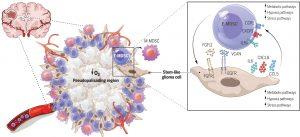Glioblastomas (GBMs) are treatment-resistant, grade 4 brain tumours with remarkable immune evasion capabilities. At the core of GBM progression are tumour stem cells, a small but critical population (5-10%) that continuously regenerate the tumour and drive its aggressiveness.
A new study has identified a crucial interaction between glioblastoma stem cells and myeloid-derived suppressor cells (MDSCs), which fuels tumour growth and immune evasion (Figure 1). The research offers a deeper understanding of how highly aggressive glioblastomas manipulate the immune system, providing potential new therapeutic targets.

Figure 1: Cross-talk between E-MDSCs and tumor cells in IDH-WT glioblastoma. Single-cell RNA sequencing of IDH-WT glioblastoma supports a mechanism of tumor growth involving cross-talk between highly metabolic E-MDSCs and a stem-like subset of glioma cells. In this model, tumor cells produce specific chemokines that attract E-MDSCs to the pseudopalisading region, where rapid growth and oxygen consumption require metabolic adaptation to a high-stress microenvironment. E-MDSCs in turn produce specific growth factors that drive tumor cell growth and aggressiveness.
The study reveals that MDSCs—a subset of immunosuppressive cells—are co-located with glioblastoma stem cells in the tumour’s pseudopalisading region, an area characterized by high metabolic stress and rapid tumour expansion. Using single-cell RNA sequencing and spatial transcriptomics, the researchers mapped over 750,000 immune cells and 350,000 tumour-associated cells, uncovering a direct molecular exchange between tumour stem cells and MDSCs that promotes tumour growth and immune suppression.
The research demonstrated a two-way communication loop between tumour stem cells and MDSCs:
- Glioblastoma stem cells produce chemokines, such as IL-6 and IL-8, that attract MDSCs to the tumour microenvironment.
- MDSCs, once recruited, secrete growth factors, including fibroblast growth factor 11 (FGF11)—a molecule never linked to brain tumours—to support tumour expansion.
- This reciprocal signalling allows glioblastomas to evade immune responses while maintaining an environment conducive to rapid, uncontrolled growth.
The team also found that tumours with a mutation in the IDH1 gene—which are generally less aggressive—had significantly fewer MDSCs and cancer stem cells. These findings suggest new therapeutic targets for treating glioblastoma by blocking key molecular interactions.
While more research is needed, this study marks a significant breakthrough in glioblastoma immunology, revealing how tumours manipulate immune cells to sustain their own survival.
Journal article: Christina Jackson et al, Distinct myeloid-derived suppressor cell populations in human glioblastoma, Science.
Summary by Stefan Botha










